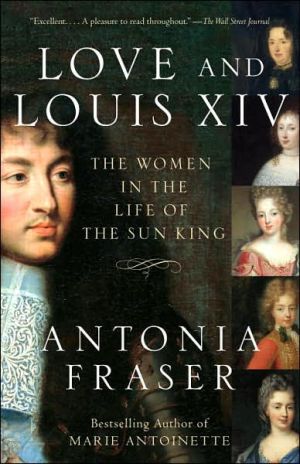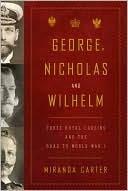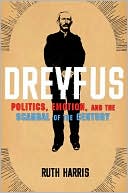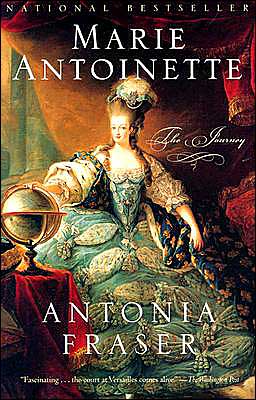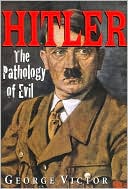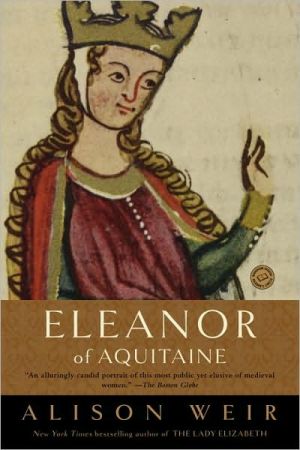Love and Louis XIV: The Women in the Life of the Sun King
Louis XIV, the highly-feted “Sun King”, was renowned for his political and cultural influence and for raising France to a new level of prominence in seventeenth-century Europe. And yet, as Antonia Fraser keenly describes, he was equally legendary in the domestic sphere. Indeed, a panoply of women — his wife Anne; mistresses such as Louise de la Vallière, Athénaïs de Montespan, and the puritanical Madame de Maintenon; and an array of courtesans — moved in and out of the court. The highly...
Search in google:
The superb historian and biographer Antonia Fraser, author of Marie Antoinette, casts new light on the splendor and the scandals of the reign of Louis XIV in this dramatic, illuminating look at the women in his life.The self-proclaimed Sun King, Louis XIV ruled over the most glorious and extravagant court in seventeenth-century Europe. Now, Antonia Fraser goes behind the well-known tales of Louis’s accomplishments and follies, exploring in riveting detail his intimate relationships with women.The king’s mother, Anne of Austria, had been in a childless marriage for twenty-two years before she gave birth to Louis XIV. A devout Catholic, she instilled in her son a strong sense of piety and fought successfully for his right to absolute power. In 1660, Louis married his first cousin, Marie-Thérèse, in a political arrangement. While unfailingly kind to the official Queen of Versailles, Louis sought others to satisfy his romantic and sexual desires. After a flirtation with his sister-in-law, his first important mistress was Louise de La Vallière, who bore him several children before being replaced by the tempestuous and brilliant Athénaïs, marquise de Montespan. Later, when Athénaïs’s reputation was tarnished, the King continued to support her publicly as Athénaïs left court for a life of repentance. Meanwhile her children’s governess, the intelligent and seemingly puritanical Françoise de Maintenon, had already won the King’s affections; in a relationship in complete contrast to his physical obsession with Athénaïs, Louis XIV lived happily with Madame de Maintenon for the rest of his life, very probably marrying her in secret. When his grandson’s child bride, the enchanting Adelaide of Savoy, came to Versaille she lightened the King’s last years – until tragedy struck.With consummate skill, Antonia Fraser weaves insights into the nature of women’s religious lives – as well as such practical matters as contraception – into her magnificent, sweeping portrait of the king, his court, and his ladies.From the Hardcover edition. The New York Times - Megan Marshall As a writer of history, Fraser has done it all—biographies, group studies, even a chronicle of England's infamous Gunpowder Plot—and done it superbly. While Love and Louis XIV doesn't quite measure up to the high standards of synthesis and narrative propulsion of her best work, the book is still entertaining and instructive…If the chief virtues of Love and Louis XIV are its sparkling vignettes and sharp character sketches…we must still be grateful to Antonia Fraser for devising so excellent a companion with which to lie back and think of France.
Chapter 1\ \ Gift from Heaven\ \ They saw in the arms of this princess whom they had watched suffer great persecutions with so much staunchness, their child-King, like a gift given by Heaven in answer to their prayers.\ —Madame de Motteville, Mémoires\ The first woman in the life of Louis XIV — and probably the most important — was his mother, Anne of Austria. When Louis, her first child, was born on 5 September 1638 the Spanish-born Queen of France was just short of her thirty-seventh birthday. This was an age at which a royal princess might well expect to be a grandmother (Anne herself had been married at fourteen). The Queen had on the contrary endured twenty-two years of childless union. Anne, as she told a confidante, had even feared the annulment of her marriage, since childlessness was one possible ground for repudiation according to the Catholic Church. In which case the former Spanish Princess, daughter of Philip III, would either have been returned to her native country or possibly dispatched to govern the so-called ‘Spanish’ Netherlands (approximately modern Belgium), as other princesses of her royal house had done, most recently her pious aunt, Isabella Clara Eugenia.\ The birth of a child, and that child a son — females could not inherit in France under the fourteenth-century Salic Law — meant that the whole position of his royal mother was transformed. It was not only the obvious delight of a woman confronted with ‘a marvel when it was least expected’, as the official newspaper Gazette de France put it. It was also the traditionally strong position of any Queen of France who had produced a Dauphin, an interesting paradox in the land of the Salic Law. This strength derived from the claim of such a Queen to act as Regent should her husband die during the minority of her son; a rule which had applied to Louis XIII’s mother when Henri IV had died, and the dominating Catherine de Médicis in the previous century.\ It was a situation that had already been envisaged at the time of Anne of Austria’s betrothal in 1612. In poetical language the future Queen was described as the moon to her husband’s sun: ‘Just as the moon borrows its light from the sun . . .’ the monarch’s death means that ‘the setting sun gives way to the moon and confers on it the power of shedding light in its absence’. (The potential bride and bridegroom were then both ten years old.) A quarter of a century later, the reality was less poetical. Louis XIII was not in good health and a Regency in the next thirteen years — the age at which a French King reached his majority — was more likely than not. How long would it be before Anne, like Catherine de Médicis, was promoting herself as an image of revered maternality at the heart of government?\ Furthermore the dynastic map of Europe was transformed. The heir presumptive to the throne of France, the King’s younger brother Gaston Duc d’Orléans, on being shown ‘physical proofs’ of the baby’s masculinity, had to accept that his rising hopes of accession had been fatally dashed. But Gaston himself had only daughters. Next in line were the French Princes of the Blood, notably the Prince de Condé and his two sons the Duc d’Enghien and the Prince de Conti; their hopes were similarly blighted.\ On the other hand the birth of a prince not only cut off hopes but also instigated ambitious thoughts of his eventual marriage to a princess. Gaston’s daughter by his first marriage, Anne-Marie-Louise de Montpensier, was the richest heiress in France from the fortune of her mother who had died at her birth. She did not allow an eleven-year gap in age to prevent her dallying with thoughts of the Dauphin as ‘my little husband’. Even more significant for the future was another equally august birth in Spain. Five days after the ecstatic Queen Anne gave birth to Louis, her sister-in-law, wife of Philip IV, gave birth to a princess.\ These two high-born babies were in fact double first cousins (with identical grandparents), since a brother and a sister of France had married a brother and a sister of Spain. Unlike France, however, Spain allowed females to succeed: Anne of Austria had had to renounce her own rights on her marriage. There was at least a theoretical possibility that the Infanta Maria Teresa would one day succeed to the throne of Spain — or her children would. Another theoretical possibility, always present in the mind of Queen Anne, was that Maria Teresa might one day make a bride for Louis.\ Under the circumstances, it is easy to understand how the infant Louis was described as ‘Dieudonné’ or ‘Deodatus’: Godgiven. And even as the years passed, the apparently miraculous nature of his conception and birth was never forgotten. One German diplomat would refer to the King’s ‘quite extraordinary birth’ over forty years after the event.\ How miraculous was this birth, so unexpected and so awe-inspiring for the mother? Certainly a great deal of prayer had been applied to the subject as the years passed. There were pilgrimages to shrines, as befitted a Queen who throughout her life liked nothing so much as to visit convents and holy places. Saint Leonard was invoked against sterility; a hermit who was believed to have founded a monastery near Limoges in the sixth century, his intercession was held responsible for many miracles. (He was otherwise the patron saint of prisoners — and after all the Queen was in the prison of her infertility.)\ The Queen was fast approaching the age at which child-bearing itself was felt to be unlikely. This was a period when women were generally held to age faster than men, losing their bloom early — ‘no woman is beautiful after twenty-two’ was a popular saying — going further downhill after thirty. Certainly, by the time of the Queen’s thirty-sixth birthday on 22 September 1637 — and thirty-five was often seen as a cut-off point — her relationship with her husband, and also with her adopted country of France, had already had a long and troubled history.\ The marriage of the two royal teenagers took place on the feast of St Catherine — 25 November — 1615. It was, it seems, consummated immediately, and after that there was a gap of more than three years. The twenty-fifth of January 1619 was the auspicious date on which the further completion of the royal union was announced in the gazette Mercure Français (it was after all a matter of state, just as the marriage had been). There were certainly rumours of royal pregnancies throughout the 1620s, and Louis XIII himself told the Venetian Ambassador later that his Queen had had four ‘wretched miscarriages’.\ If the marriage was not egregiously unhappy by royal standards — notoriously low — it was certainly unhappy enough. Anne was an extremely attractive, even beautiful woman with her full, voluptuous figure, her thick bright chestnut hair, her luminous pale skin and her dark eyes with the green glints which gave them a special sparkle. She had her share of feminine vanity and was especially proud of her much-admired white hands, which seemed made ‘to hold a sceptre’. As for her character, that was made up of contradictions. Anne was certainly pleasure-loving — she adored the theatre and gambling — but at the same time she was extremely pious.\ Her piety did not stop Queen Anne from being a romantic, and it was not difficult for men to fall in love with her: ‘her smile won a thousand hearts,’ wrote Madame de Motteville, her lady-in-waiting. She was also galante in the crucial French term of the time which shimmers with different meanings throughout this period. In the case of the Queen, it meant flirtatious in the courtly, essentially innocent manner of the well-chaperoned Spanish Infanta she had once been. When the handsome Duke of Buckingham, who was gallant in every sense of the word, had ‘the audacity’ to court her in a famous scene in a garden, the Queen recoiled in horror. Nevertheless, in the opinion of Madame de Motteville, an important source for Anne’s intimate feelings because she understood the Spanish world, ‘if a respectable woman could love a man other than her husband, it would have been Buckingham who appealed to her’. The Princesse de Conti had a more cynical view: she would vouch for the Queen’s virtue from the waist down, but not from the waist up.\ The sexuality of the husband of this romantic and unfulfilled woman was what would now be called troubled. Louis XIII formed lugubrious attachments to both men and women: late in his life, the Marquis de Cinq-Mars became his favourite. But at one point Louis fell yearningly in love with Marie d’Hautefort (his conjugal visits to Anne were said to have increased in consequence). However, when his friend the Duc de Saint-Simon offered to act as a go-between, the King was shocked: ‘the more my rank as king gives me the facility to satisfy myself,’ he said, ‘the more I must guard against sin and scandal.’ Low-spirited and willingly dominated by his great minister Cardinal Richelieu, Louis XIII was one half of an incompatible pair.\ Furthermore, if the marriage did not provide a Bourbon—Habsburg heir, it did not bring about peace between Bourbon and Habsburg kingdoms either. Not long after Anne came to France, the slow strangulation of Europe in that long and complicated conflict known later as the Thirty Years War began. In this conflict, at the instigation of Cardinal Richelieu, the French and Spanish found themselves on different sides. Anne rejected the idea that she remained at heart a Spanish princess. Her tastes might be Spanish, from a predilection for late hours to a yearning for Spanish iced drinks and Spanish chocolate, but she prided herself on having become a Frenchwoman. Louis XIII on the other hand was pervaded with suspicions of his wife’s disloyalty and over the course of their marriage remained convinced that she ‘had a great passion for the interests of Spain’.\ It was a situation which perennially threatened the daughters of great monarchs married off abroad to further their country’s interests. One can therefore appreciate the wise comment of Erasmus on the subject in the sixteenth century. In his Education of a Christian Prince, he pointed out the incongruity of such matches, which never actually did lead to international peace, and advised kings and princes to marry one of their own subjects instead.\ Various opposition movements in the country tended to implicate the King’s brother — and of course heir presumptive for many years — Gaston d’Orléans. Anne was also suspected of joining with him, and in the ultimate alleged conspiracy before her fortunate transformation into the mother of a son, she was accused of plotting to marry Gaston after the King’s death. And for all her French heart, she still wielded a Spanish pen, corresponding with her brother Philip IV, King of Spain. This was a matter which, when discovered, led to her disgrace in the summer of 1637. In due course her enemy Cardinal Richelieu secured from Anne a humiliating recantation, signed on 17 August. In the process, one of Anne’s servants — her cloak-bearer Pierre de La Porte — was arrested and tortured but refused to implicate his mistress further. It was understandable therefore that La Porte in his memoirs would refer wryly to Louis as being ‘as much the son of my silence, as of the prayers of the Queen and the pious vows of all France’. It is certainly true that under these unpropitious circumstances some kind of miracle was generally felt to be necessary.\ Of course there were, as there always would be, wags who suggested that the miracle had a more human origin. The aggrieved younger brother Gaston d’Orléans said that he was quite prepared to believe Louis Given by God had come out of the Queen’s body, but he did not know who the devil had put him there. As to that, popular scandal was quite prepared to supply the name of the King’s minister Cardinal Richelieu, simply because of his political power (a ludicrous misreading of the relationship between Anne and the Cardinal), with rhymes suggesting that the King had prayed ‘to the saints, men and women’ every day and Richelieu had prayed too but ‘he succeeded much better’.\ The religious of all sorts who prayed for the Queen’s fertility were many of them, like rainmakers, ready to claim a successful result. A nun, a former favourite of Louis XIII named Louise Angélique de La Fayette, was said to have asked her priest to choose a great feast of the Church — presumably the Feast of the Immaculate Conception on 8 December — to remind her platonic admirer of his conjugal duties: the result was the immediate conception of a more earthly sort.\ One story however does have the particular distinction of being believed by Queen Anne herself, and later by her son. This was the prediction in a Paris monastery of a monk named Brother Fiacre, to whom the Blessed Virgin Mary appeared in a vision on 3\ November 1637. He was told by the Virgin to inform the Queen that she would shortly become pregnant; then he instructed the royal couple to make three novenas at the cathedral of Notre-Dame and the church of Notre-Dame-des-Victoires in Paris — and most importantly at the shrine of Notre-Dame-des-Grâces, an obscure chapel at Cotignac in Provence. (Cotignac may well have been one of the old pagan fertility sites, dedicated to forgotten goddesses, which had been transformed into a place of veneration for the Virgin.)\ In the end it was Brother Fiacre himself, accompanied by the sub-prior of his order, who made the pilgrimage to Cotignac. By the time Brother Fiacre was actually received by the royal couple on 10 February 1638 the Queen was already pregnant. This meant that it was not so much conception as the desired masculine gender of the baby which was now the object of concern. The importance of Brother Fiacre’s mission was signified by the fact that the King gave orders for free board and lodging to be provided for the pilgrim pair on their way.\ It is evident that Brother Fiacre’s sincerity had made a great impression on Queen Anne when they met. Six years later she called the monk to her presence again with the words: ‘I have not forgotten the signal grace you have obtained for me from the Blessed Virgin who gave me a son. I have had a great picture made where he [Louis] is represented in front of the mother of God to whom he offers his crown and sceptre.’ And the monk duly traveled once more to Cotignac with the picture. Nor was this the end of the connection. Brother Fiacre, even as an old man, was allowed privileged access to Louis, for the role he was believed to have played ‘in the happy birth of Your Majesty’. When the monk died, it was on the orders of the mature King (who paid for the journey) that his heart was taken to Notre-Dame-des-Grâces.\ That was the supernatural reasoning, one that the pious Anne clearly accepted, given the respect paid to Brother Fiacre. A more down-to-earth explanation was provided by a story involving Louis XIII, a hunting expedition near Paris cut short by an unexpected storm, and given that the King’s separate apartments at the Louvre were not prepared, the need to take refuge in those of his wife on the night of 5 December 1637. . . The result of this unscheduled propinquity was Louis, born exactly nine months later. Unfortunately the Gazette de France, the official source of royal movements on any given day, does not confirm joint occupation of the Louvre on that particular night (although it is true that Anne was there). The King and Queen were however together at their palace of Saint-Germain from 9 November for six weeks. The couple moved to the Louvre on 1 December, after which the King went hunting at Crône, and by 5 December was at his hunting lodge of Versailles. It was the prolonged period of opportunity in November which led the doctors to project a birth at the end of August.\ Leaving aside the supernatural, and given that the dates of the storm do not fit (unless the King made a speedy and unrecorded stop at the Louvre on his way to Versailles), the truth was surely more prosaic. The conjugal relations of a King and Queen were never subject to the ordinary laws of preference, attraction or even anger and disgust. The need for an heir had hardly diminished, and at some point in the autumn, following the summer crisis, relations were simply resumed with happy results. Yet even if Louis XIII himself irritably if understandably observed: ‘It is scarcely a miracle if a husband who sleeps with his wife gives her a child,’ the circumstances of the conception, followed by the birth of the long-desired son, were widely held to be extraordinary — and above all by the baby’s mother. ‘Godgiven’: it was a view of himself as someone of special destiny that Anne would impress upon the future Louis XIV.\ From the Hardcover edition.
List of Illustrations ixAuthor's Note xiiiChronological Political Summary xviiGenealogy xxivPrincipal Characters xxixSpringGift from Heaven 3Vigour of the Princess 20Peace and the Infanta 40Our Court's Laughing Face 61Sweet Violence 82SummerThe Rise of Another 103Marriages Like Death 122A Singular Position 142Throwing Off a Passion 161Madame Now 179AutumnThe King's Need 201Grandeurs of the World 223Becoming a Child Again 244WinterGaiety Begins to Go 265We Must Submit 289Going on a Journey 307Never Forget 321Notes 323Sources 345Index 357
\ From Barnes & NobleHaving elegantly disposed of the ill-fated Marie Antoinette in her previous book, royal biographer Antonia Fraser now ventures into the crowded female-dominated court of Louis XIV (1638-1715), the "Sun King" who ruled France for 72 years. In his relations with women, as in every arena of his life, the "Great Monarch" exhibited an abundance of energy: He had two wives; three longtime official mistresses; and numerous fleeting, occasionally fruitful liaisons. By consensus count, he fathered at least 18 legitimate and illegitimate offspring. Fraser choreographs these alliances for us with enviable ease. Love and Louis XIV confirms her status as our era's premier court chronicler.\ \ \ \ \ Caroline WeberDiverse is the operative word here, for these women had little in common apart from the love they bore the sovereign. Although she does not explain what (apart from that roving eye) caused Louis XIV to feel so "full of romance" toward so many different kinds of ladies, Fraser offers an engaging overview of this varied cast of characters, beginning with his mother, the "fierce[ly] maternal" Anne of Austria. According to Fraser, Anne's devotion to her oldest son -- who became Louis XIV in 1643, at age 4 -- imbued him with a sense of "generosity and courtesy to women" that would characterize his subsequent relationships with the fairer sex.\ — The Washington Post\ \ \ Megan MarshallAs a writer of history, Fraser has done it all—biographies, group studies, even a chronicle of England's infamous Gunpowder Plot—and done it superbly. While Love and Louis XIV doesn't quite measure up to the high standards of synthesis and narrative propulsion of her best work, the book is still entertaining and instructive…If the chief virtues of Love and Louis XIV are its sparkling vignettes and sharp character sketches…we must still be grateful to Antonia Fraser for devising so excellent a companion with which to lie back and think of France.\ —The New York Times\ \ \ \ \ The New YorkerAdelaide of Savoy, a favorite companion of Louis XIV during his dotage, remarked, “Under a king, a country is really ruled by women.” Fraser’s history of the court of the Sun King, seen through the lens of the women closest to him, is a highly readable confection, and unfolds as a sequence of cameos. There is Queen Anne of Austria, Louis’s steely mother and regent, who carefully molded the infant King into an Apollo adored by the court; and his wife, Marie-Thérèse of Spain, who gave him no trouble except by dying. Then comes a trio of mistresses: Louise de La Vallière, who became a nun as recompense for her sins; Athénaïs, voluptuous and fecund; and Madame de Maintenon, the discreet and redoubtable confidante of his later years. With vivid wit, Fraser demonstrates that within the edifice of the monarchy there were deep crannies of ordinary affection.\ \ \ \ \ Publishers WeeklyProlific royal biographer Fraser (Marie Antoinette) has assiduously researched her measured yet engrossing study, shedding welcome light on the galaxy of influential women who orbited the dazzling Sun King. The most important woman in Louis XIV's life, in Fraser's telling, was probably the first-his mother, Anne of Austria. The voluptuous, pleasure-loving but pious and dignified queen regent inculcated Louis with the notion that he was a godlike miracle who was nevertheless accountable to the deity for his sins. As this narrowly focused history suggests, Louis was constantly trying to reconcile his gargantuan sexual appetite with his duty to his people and his God. Louis gave up his first love, the bold and amusing Marie Mancini, to marry his graceless first cousin, the Spanish princess Maria Teresa. A serious flirtation with his charming sister-in-law Henriette-Anne, sister of England's Charles II, ended when Louis fell for Charles and Henriette's decoy, the timid virgin Louise de La Valliere. In sexual thrall to the intelligent, magnetic Athenais, the Marquise de Montespan, the king intriguingly threw her over for Francoise Scarron, the puritanical governess to their bastards. Lastly, Louis gave his heart to his spirited granddaughter-in-law Adelaide, who died of measles within days of her husband, the Dauphin. (Oct. 17) Copyright 2006 Reed Business Information.\ \ \ \ \ Library JournalInternationally acclaimed biographer and historian Fraser has written another fascinating and accessible biography. Her focus is on the private life rather than the power and political achievement of that larger-than-life sovereign, Louis XIV of France. Beginning with his relationship with his mother, Anne of Austria, Fraser argues that the happiest moments of Louis's life were associated with women. She details many (though admittedly not all) of his liaisons, interweaving the narrative with rich historical insights about the customs of court life, including practices regarding contraception, sexuality, and sexual initiation. A secondary theme is the apparent contradiction between the enormous power that the Catholic Church held over conscience and behavior at the time and the king's clearly immoral actions. Absolute kings, as God's representatives on Earth, were expected to behave better than their subjects, and Fraser shows how Anne of Austria worried about her son's promiscuity and his salvation. Fraser also wonders about the extent to which Louis's paramours might be termed victims, and she tries to uncover the perceptions that they had of themselves and of their relationship with Louis. She stresses his generosity and courtesy to them and his enjoyment of female company outside the bedroom. A glossary of principal characters and a chronological political summary help general readers understand the historical context. Recommended for public libraries. [See Prepub Alert, LJ 6/1/06.] Marie Marmo Mullaney, Caldwell Coll., NJ Copyright 2006 Reed Business Information.\ \ \ \ \ Kirkus ReviewsAltogether at ease with the mores of the ancien regime, Fraser (Marie Antoinette, 2001, etc.) eschews a detailed biography of Louis XIV to focus instead on the women who shaped and were shaped by France's most glorious ruler. He was king for 72 years, time enough to build Versailles, wage numerous, mostly unsuccessful, wars and accumulate a rich history with the opposite sex. Louis's mother, Queen Anne, gave birth at 36-a then-astoundingly late stage in life for pregnancy-lending an immediate air of the miraculous to the future monarch. Anne established an unusually close relationship with her son, who never entirely erased from his mind her mixture of beauty and piety as a template of female perfection. Louis abandoned his teenage liaison with the unsuitable Marie Mancini to marry Spanish Infanta Maria Teresa. As Queen Marie-Therese, she accommodated two important mistresses, Louise de La Valliere and the Marquise de Montespan, and drew from Louis the final tribute that she gave him no trouble except by dying. After Marie-Therese, he secretly married Madame de Maintenon, whose demeanor was remarkably like that of his mother. Fraser paints each of these women in full and offers sketches of a succession of minor mistresses, one night stands, sisters-in-law (including the hilariously vulgar and bitchy wife of Louis's homosexual brother), princesses and even an exiled foreign queen, all of whom engaged the king's genuine interest. To help keep track of this large cast, the profusion of changing titles and the dizzying succession of bastards, the author provides a useful guide to the principal characters. Courtiers meticulously charted the king's amorous adventures, and Fraser excels atreproducing the hothouse atmosphere in which the monarch's raised eyebrow might portend a serious change in someone's fortune. Uncomfortably aware of the Church's opposition to his notorious love life, Louis fully indulged himself during his heyday before turning in old age to a greater concern for his salvation. An acutely sensitive group portrait of the women who basked in the Sun King's reflected glory.\ \
